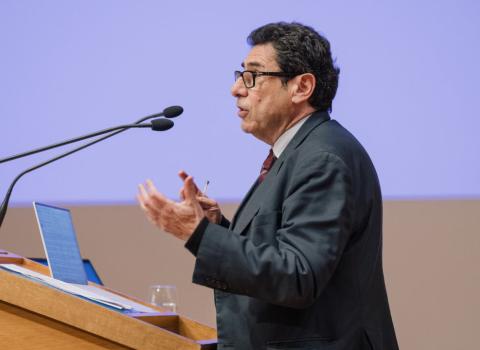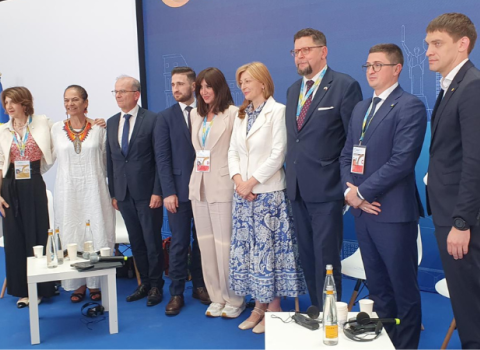
Jennifer Chayes, head of Microsoft’s latest research centre: “If you don’t innovate, you die.” Image courtesy Microsoft Research.
“The things that change our lives broadly take a long time,” Craig Mundie, Chief Research and Strategy Officer for Microsoft Corp., said at the MIT Emerging Technologies Conference last week. Mundie, charged with charting Microsoft’s long-term innovation strategies, said he looks at a three- to 20-year time horizon.
His words had a particular resonance for delegates, given that Microsoft established its latest research centre in Cambridge, Massachusetts, in July.
The managing director of the Microsoft Research New England Lab, Jennifer Chayes, warned, “If you don’t innovate, you die.”
For many large corporations, innovation has come to mean building and fostering intrapreneurship - combining the entrepreneurial spirit with working in a large organisation. For Microsoft, that includes the new Cambridge laboratory, which brings together mathematicians, physicists, cryptographers and social scientists such as economists, psychologists and sociologists to try to understand, model and enable computing and online “experiences” 20 years down the road.
“Microsoft supports us to build an interdisciplinary lab without a mandate to do anything specific,” said Chayes, a former academic researcher, during a panel on intrapreneurship. This is the company’s sixth research lab, which also has research centres in Redmond, WA; Bangalore, India; Beijing, China; Cambridge, England; and California’s Silicon Valley.
Who can help to foster innovation?
“It’s important to have a very diverse group of people,” said Chayes, who is the coauthor of more than 100 scientific papers and more than 20 patents. “We’re building a team now of quantitative and qualitative people. Gender differences are important. Sometimes I am the only woman in a group of 100 people. I don’t think that’s good for innovation.”
The ‘no jerks’ policy
Picking the right people is critical, believes Chayes. “If you don’t pick the right people, you are in trouble. I love building teams because I don’t like taking on other people’s mistaken hires, people who are not productive, or innovative, and who are holding back the innovations of others,” she said. “I have a ‘no jerks’ policy. It doesn’t matter how smart someone is, if they’re a jerk, they can ruin a team.”
It’s important to tell intrapreneurs to not be afraid to fail, she said, and to reward them financially and in other ways. “The currency in research isn’t just IP,” she said. Microsoft owns the IP of its researchers. “It’s prestige, contributions to the field. If you want to encourage innovation in your organisation, be a champion of the people in your organisation, so that they get credit for their work…I get their reflected glory anyway.” She added that if a team knows their manager supports them, they’ll take risks.
While to retain talented researchers it’s important to reward them and make sure they are getting recognition in various ways Chayes said she’s also told people to leave to pursue their dream if it doesn’t fit in with the company’s goals.
Getting people from different disciplines to interact initially proved a challenge, but was overcome by bringing in a common denominator: food and drink. “We have tea and food at 3:30pm every day. That draws people out,” Chayes said.
Take a break in a Petri dish
“The break area is like a Petri dish. People from different labs talk,” agreed Holly Heaslet Soutter, principal scientist for Pfizer Global Research and Development’s Lead Discovery Technologies.
Soutter advised intrapreneurs to promote themselves and their ideas. “It helps to have a manager to go to bat for you, but don’t be afraid to go to bat for yourself,” she added. “I have no qualms going to the head of research at my site. You need to make a compelling case about why they need [what you are proposing] and demonstrate the value of intrapreneurship, such as accelerated timelines of getting a product to the goal faster.”
Chayes agreed. “I got a coach and mentor very high up in Microsoft and learned I have to give the higher-ups why my expensive proposition is good for the needs of the company,” she said. “A mentor can be your advocate and can get you an audience with the right people.”
She added that it’s important for an intrapraneur to make his or her vision align with a need of the company. When she pitched the Cambridge lab, it got approved in three weeks, which is fast even by Microsoft standards. “I told them where there are gaps and how to fill them. I showed them there are real needs in the company.” Chayes, a mathematician and physicist with an undergraduate major in biology, now has 35 people at the lab, including interns and senior scientists.
“You need vision to get people to follow you and not go to the next company,” she said. “I need to get executives excited about my vision and that I can bring great people into the company to do this and they’ll stay and help the company grow. That is a compelling argument.”
Susan Foley, executive director of the Research Centers at Babson Executive Education, added that a lot of senior executives don’t understand innovation and need to be educated about it. “If there isn’t a CEO commitment, it won’t work. A lot of senior executives don’t know their role in innovation. So give them a role.”
The conference also honoured innovators under age 35 who have made discoveries ranging from conserving or producing energy, to taking advantage of the body’s capacity to heal itself. It’s important to recognise such young entrepreneurs, James Kim, senior partner at venture capital firm CMEA Ventures, told Science|Business. “This is game changing, transformational stuff,” he said, adding that the US now is too focused on the short term. “I’m worried about losing our technological edge.”





 A unique international forum for public research organisations and companies to connect their external engagement with strategic interests around their R&D system.
A unique international forum for public research organisations and companies to connect their external engagement with strategic interests around their R&D system.